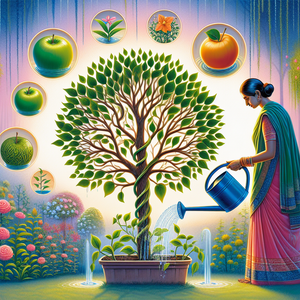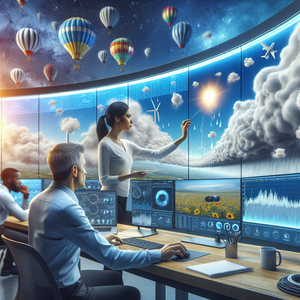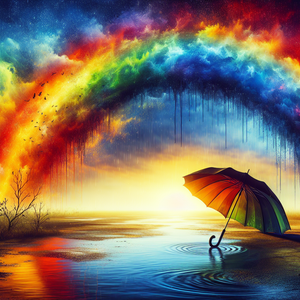Tomorrow's Weather in Art and Culture

Literature has a long-standing relationship with weather, serving as both a backdrop and a catalyst for narrative development. Authors have long utilized weather to create mood, build tension, and reflect characters' inner states. For instance, in Shakespeare's works, storms often symbolize turmoil or chaos, embodying the emotional tempest of characters. Similarly, modern literature has begun to reflect the unpredictability of climate change, inspiring writers to explore themes of anxiety and hope. Contemporary novels like "The Overstory" by Richard Powers not only reflect on the beauty of nature but also highlight the alarming realities of climate change, effectively intertwining weather with human stories. This novel, along with others, urges readers to grapple with the environmental issues we face today, using weather as a narrative device to underscore the urgency of our ecological crises. Poets, too, frequently employ weather as a metaphor for emotions. Rain may symbolize sorrow and grief, while a sunny day can evoke joy and optimism. As meteorological events become more extreme due to climate change, literature increasingly addresses these shifts, reflecting societal concerns and prompting readers to consider their relationship with the environment.
Film and Weather: Setting the Scene
In cinema, weather serves as a powerful tool for storytelling. Filmmakers harness the elements—rain, sunshine, and snow—to evoke specific emotions and enhance narratives. For example, in "The Pursuit of Happyness," the downpours that accompany protagonist Chris Gardner's struggles amplify his feelings of despair. Conversely, bright, sunny scenes often accompany moments of triumph and joy, painting an emotional landscape that resonates with viewers. With climate change at the forefront of global discussions, filmmakers are more than ever incorporating weather phenomena into their narratives. Movies like "The Day After Tomorrow" dramatize the potential consequences of climate change, using extreme weather events as a plot device that compels audiences to engage with the topic on a personal level. This blending of entertainment and education encourages viewers to reflect on their own experiences with weather and climate, bridging the gap between art and activism.
Visual Arts: Capturing the Atmosphere
Visual artists have historically turned to nature and weather for inspiration. From the tempestuous skies of Turner’s seascapes to the serene landscapes of Monet, weather has been a central theme in art history. Contemporary artists continue to explore the relationship between climate and creativity, often using their work to comment on pressing environmental issues. For instance, Olafur Eliasson creates immersive installations that invite viewers to experience weather phenomena firsthand, such as his "Weather Project" at the Tate Modern, where he simulated the sun within an enclosed space. Such works not only captivate the audience but also provoke critical conversations about how we interact with our environment and the future of our planet. Street art and murals also reflect the immediacy of weather impacts on urban life. Artists depict scenes of flooding or heat waves, serving as visual commentary on climate change and its effects on communities. These public displays not only beautify urban spaces but also challenge onlookers to consider their role in environmental stewardship, making climate change a visible and urgent topic.
Tomorrow's weather is more than just a forecast; it is a rich source of inspiration that permeates our cultural landscape. Through literature, film, and visual arts, artists respond to the environmental changes that shape our world, using their mediums to reflect societal concerns and provoke thought. As we continue to grapple with the realities of climate change, the interplay between weather and art will remain a vital conversation, encouraging us to appreciate the beauty of nature while engaging in the urgent dialogue about our planet's future. By recognizing the artistic expressions born from weather phenomena, we can better understand the profound impact these elements have on our lives and culture. Tomorrow's weather is not just a prediction; it is a canvas for creativity and a call to action for a more sustainable future.
Environmental Artist
Core Responsibilities
Create art that addresses environmental issues, often incorporating natural elements or eco-friendly materials.
Engage with communities to raise awareness about climate change through public installations or workshops.
Required Skills
Strong background in visual arts, including techniques in sculpture, painting, or installation art.
Knowledge of environmental science and sustainability practices.
Common Employers
Art galleries
Environmental NGOs
Public art organizations
Climate Change Communication Specialist
Core Responsibilities
Develop and implement communication strategies to raise awareness about climate change and its impact on society and culture.
Create engaging content for various platforms, including social media, blogs, and print, that translates complex scientific data into accessible narratives.
Required Skills
Excellent writing and editing skills, with a focus on storytelling.
Familiarity with climate science and proficiency in digital marketing tools.
Common Employers
Environmental advocacy groups
Government agencies
Educational institutions
Cultural Anthropologist
Core Responsibilities
Conduct research on how weather patterns and climate change affect cultural practices and artistic expressions in different communities.
Analyze data and present findings that contribute to understanding the intersection of culture, environment, and human behavior.
Required Skills
Strong analytical and research skills, with experience in qualitative methods.
Proficiency in cultural theory and environmental studies.
Common Employers
Research institutions
Universities
Cultural organizations
Film Producer - Environmental Documentaries
Core Responsibilities
Oversee the production of documentaries that focus on climate change, environmental issues, and their cultural implications.
Collaborate with writers, directors, and crew to ensure the narrative effectively communicates the urgency of the subject matter.
Required Skills
Experience in film production, including budgeting, scheduling, and post-production processes.
Strong understanding of documentary storytelling and environmental issues.
Common Employers
Documentary film studios
Non-profit organizations
Educational media companies
Literary Editor - Eco-Fiction
Core Responsibilities
Edit and develop manuscripts that address themes of nature, climate change, and environmental ethics in fiction.
Work closely with authors to enhance their narratives while ensuring that they accurately reflect ecological concerns.
Required Skills
Strong background in literature, particularly in genres focusing on environmental themes.
Excellent editing and communication skills, with a keen eye for both narrative structure and thematic depth.
Common Employers
Publishing houses
Literary magazines
Independent presses focusing on eco-fiction


